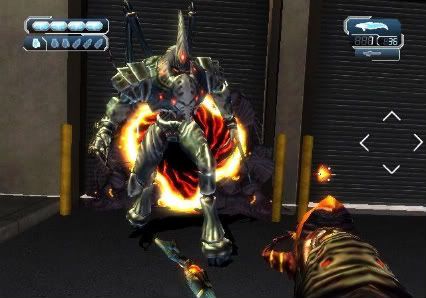
Remember the Nintendo Wii? Of course you do, everyone and your dog owns one. It is the little white (or now black) box that couldn’t satisfy you if you had the nerve to consider yourself “proper hardcore.”
That’s a half-truism. Every now and then a more mature game with a different target audience than what the Wii generally caters to is released, such as No More Heroes, Madworld, or House of the Dead Overkill. Unfortunately, these games usually tank on the charts because the audience these games are aimed at probably doesn’t own a Wii, or if they do, they’ve long since forgotten about it. Why? Games that target the traditional fan base took a little too long getting to the machine, or are so few and far between that they can often slip by the public unnoticed.
The Conduit, released in the summer of 2009, was one of those games that slipped by the radar. There was a lot of hype leading up to its release, but once it hit store shelves the game received mixed reviews from industry leading critics, and worse than that, it had box art that screamed “bargain bin.”
Okay. Honestly, that was a larger introduction than I’m used to writing, and chances are that you, the reader, have stopped doing your job. That is, uh, reading.
Conduit 2 (the developers dropped the “The” from the title) is coming out in the fall of this year, and if all goes according to plan, it’ll blow the pants off of not only the original, but what you expect from a Wii shooter.
First off, let’s be clear: developer High Voltage Software (HVS) is smart. Many people consider the original Conduit to be a technological marvel on the Wii console. The Quantom3 engine has been refined once again and the effects are immediately noticeable. Conduit 2 looks phenomenal. Wii release or not, the game looks good. It’d be mind blowing in full 1080p. HVS knows what they are doing with visuals.
But what really makes HVS so intelligent is that they listen to the gamers. They listen to the critics. Yes, most companies say they do, but these guys really are. In this day and age you have to. There is so much competition in the market that you can’t afford to ignore what the users online are talking about. You have to compete for the love. You have to compete for the money.
One of the complaints critics made was about boss battles. In the original, there wasn’t so much bosses as there were regular, powered up regular enemies. Gameplay design flaw number 1. In the sequel, there are full on bosses with full on battles. Early levels on display showcased a canned fight scene versus a rather hefty leviathan.
Working around Nintendo’s Friend Code policy, HVS has developed their own in-game Rivals List. This will allow you to bookmark friends and enemies in a quick and easy manner, rather than using the clunky Friends Code option delivered to you by Nintendo in most system releases.
Wii Motion Plus? Well, of course. It’d be absolutely juvenile for High Voltage to release a game catering to this particular market without accessories for the hardcore. Interestingly enough, however, HVS isn’t going to use Motion Plus for your traditional 1-for-1 movement tracking, and instead will use the optional add-on for recalibration of the controller. Essentially, when you move your Wii remote cursor off screen, the device will help recognize it quicker.
There are improvements to be mentioned for sure but to be frank, Conduit 2 looks strikingly similar to The Conduit. If you’re a Wii gamer looking for a more traditional first person shooting experience, check out this game. If by chance you are regular, run of the mill Nintendo Wii user (there are 70+ million of you), you will probably walk right by HVS’s newest offering, looking for a friendly family title.
]]>
Neither Sonic Team nor Sega have been good friends with the Sonic loving side of the gaming community these past ten years. Countless times Sega has ignored what the fans have been asking for, and because of this, we’ve seen Sonic sales continue to dwindle with each and every release. Sales have become so infinitesimal that they are now almost direct-to-bargain-bin discount games.
Well, that might be about to change.
The recently announced Sonic Colors was shown off on stage floor, and described in detail behind closed doors by some of the game’s high ranking Japanese developers. Interesting fact: the game isn’t going to be produced entirely in Japan. In fact, much of the story (which is said to take place directly after the events of Sonic Unleashed) in Colors will be produced in North America. The reasoning? Officially, Sega believed an American take on the blue rodent might appeal to a broader audience.
Speaking of story, Eggman has kidnapped a bunch of alien worlds and chained them together in space with the aspirations of creating a theme park. Uh, the largest theme park. This is clearly a story much more acceptable to Western audiences.
Much like the episodic Sonic The Hedgehog 4 set to hit consoles later this year, Sonic Colors is heading back to the series’ traditional 2D platforming roots. No longer is it an action game on rails, but it is taking what made the blue speedball so popular in the early 90’s and refurbishing him with updated visuals and gameplay mechanics.
Aside from your left to right scrolling, a la traditional Sonic games, the user can now make their hedgehog perform a number of special moves, based upon the power up they receive from the alien “Whisp” inhabiting that area. For instance, the two Whisps on display at E3 were Teal or Yellow. Sonic can, with the Teal colour, project himself like a laser and either burn through enemies at a tremendous speed, collecting points and demolishing them all in a single dash attack, or navigate to a higher level of playing. With the yellow Whisp, Sonic can dig through the dirt with his spinball technique and reach areas previously inaccessible to a regular humanoid.
That being said, a player may ignore these powers if they choose to. It was bragged by developers that the levels would be designed well enough that there were multiple paths through each level designed for every type of player. Personally, I played it with tons of Whisp power ups.
Another thing worth mentioning is that Sonic no longer handles out of control. There were elements of previous games that were hard to deal with because Sonic might accelerate too speedily. That isn’t the case here. If you let your thumb lift off of the Nunchuck remote, Sonic will almost instantly grind to a halt. This is possibly the single biggest improvement to gameplay that should have been there all along. Sonic now has control.
While the Nintendo Wii edition is being touted as the triple ‘A’ release of the game, there will also be a DS version utilizing mechanics from the Wii iteration, namely the Whisps, as well as elements from previous DS Sonic games. Specifically, dual-screened levels, which are difficult to master your first run through.
While no specific street date has been leaked as of the time of this article, Sonic Colors for both the Wii and the DS is expected to have a late 2010 release date. The demo shown off at E3 was quite sound and if Critical Gamer had a “Surprise of the Show” award, I’m sure this would be a top contender.
Sonic Colors for the Wii will not utilize Wii Motion Plus, but quite frankly it has no reason to do so at all.
]]>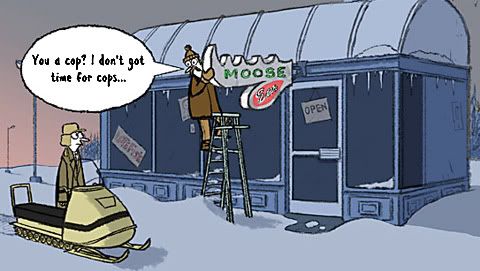
In keeping with Telltale Games’ distribution method of downloadable episodic content, Nelson Tethers: Puzzle Agent, is set to steal your bandwidth later this month.
The mission of Puzzle Agent is to unravel the story of Scoggins, Minnesota, a small town featuring a very Twin Peaks style weirdness – plus Telltale’s traditional comedic beats and timings. You might never find yourself laughing out loud but at the very least, you’ll find yourself consistently entertained.
The game revolves around your protagonist Nelson Tethers (Lead Puzzle Researcher of the FBI). Every time he asks a question, he is answered with a different sort of puzzle. One of the puzzles on demo was arranging logs around town (on a mini-map) so that Tethers could bounce off them without fully submerging his snowmobile in countless feet of snow. Yeah. It was icy out, and the results were funny.
When puzzles were in play, there were often occasions where the user had trouble solving the problems. If this was the case, Tethers could “buy” hints, by chewing bubble gum he had collected throughout the game up until that point.
What sets this game apart from other recent Telltale adventure games was the chosen art style, developed by Canadian independent comic artist, and long time contributor to the games industry, Grahm Annable. The animation here is very distinctive, and very similar to the “squiggle vision” techniques that were oh-so popular in the early 2000’s. The animation was rendered in key frames only, which was an interesting choice. It seems unnatural, and if you were to watch the trailer online, you’d wonder if your media player was malfunctioning. I assure you, however, that this technique serves a purpose, and that is making itself stand out in your mind.
Nelson Tethers: Puzzle Agent lands on the PC, Mac, iPhone and iPad platforms before the end of June.
]]> Take the familiar formula of a real-time strategy game. Take the ingredients from any massively multi-player RPG. Now put them in a locked, dark closet for a couple hours.
Take the familiar formula of a real-time strategy game. Take the ingredients from any massively multi-player RPG. Now put them in a locked, dark closet for a couple hours.
Well, if they were people, you’d have a baby nine months later. In the world of game development, however, it’s been 5 years. 5 years, Trion has spent developing this enticing marriage of strategy MMO. 5 years, Trion has been developing their in-house engine, Glyphx.
Unlike many RTS’, or MMO’s, End of Nations (EoN) is attempting to be streamlined and easily accessible to almost everyone, but at the same time trying hard to develop a game that might still appeal to the traditional, core audience. It seems to be quick, responsive, and doesn’t bog the user down with menus.
The player is given a base of operations which can never be attacked. For some people, defence is fun, but everyone likes high scoring games more. In EoN, the user is always on the attack. If you’re performing quest missions, you’ll often find yourself attacking bases with ground forces, troops and air strikes, sure. In player vs. player though, you’ll find yourself merely attacking other players and their armies. The users bases will always be out of reach. Well, they are there, they just don’t take damage.
 Another interesting tidbit is that any player can jump in and out of skirmishes. It is an MMO of course, but it is also a RTS, and the idea is a little far out there.
Another interesting tidbit is that any player can jump in and out of skirmishes. It is an MMO of course, but it is also a RTS, and the idea is a little far out there.
Like an MMO, the user can customize his army, which is acting in place of one single character, and this military can be upgraded just the same. When you defeat an enemy’s war effort, you can reverse engineer his technology, and then develop it for yourself. Naturally, your military also levels up, so to speak. Though instead of gaining +5 speed, however, you gain more blueprints or research points which can also be used to upgrade your rolling death machine. These upgrades can be applied at the beginning of every play; you can customize weapon load outs, colours and decals. To put it simply, it’s an in-depth element that looks very interesting and easy to use.
As you would also expect with an MMO, these maps are huge. As of E3 2010, Trion has admitted that their largest map would be able to accommodate 50-60 individual armies. That is, for lack of a better term, enormous. At the starting point, there will be a place to receive quests, but most will boil down to “kill that guy.” And they should, because it’s fun.
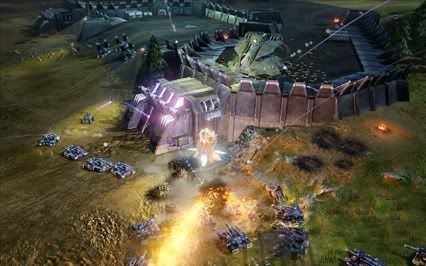 The world that Trion has crafted is a beautiful one, and what really sets it apart from other games is the attention to detail. Sure, everyone makes fire and flame effects look good now, but how many games allow you to zoom in closely to a triage unit and let you see your players get worked on by medical professionals? Look closely and you’ll even see some of your men puking from exhaustion or fear. Trion is really, really trying to create life on the battlefield.
The world that Trion has crafted is a beautiful one, and what really sets it apart from other games is the attention to detail. Sure, everyone makes fire and flame effects look good now, but how many games allow you to zoom in closely to a triage unit and let you see your players get worked on by medical professionals? Look closely and you’ll even see some of your men puking from exhaustion or fear. Trion is really, really trying to create life on the battlefield.
Not scheduled for release until 2011, Trion is already off to a great start. The demo they had running looked like a beta-phase product, meaning that if it looks this good already, next year will be amazing.
One thing not really touched on was whether or not there would be a subscription fee (which there is), coupled with the ability to pay real world money for, I don’t know, opalescent tank colours. It is more than a year away from release, however, so this is a problem easily overlooked.
]]> Future Soldier looks to be another stand-out title in a strong year for Ubisoft.
Future Soldier looks to be another stand-out title in a strong year for Ubisoft.
Taking an already established brand and making it something even more special isn’t easy, but that is, quite frankly, Ubisoft’s modus operandi. Ghost Recon has been around for many years now, and has achieved success by taking a popular genre, the third person shooter, making it as realistic as possible, and then continuing to improve the franchise with the subsequent iterations.
It isn’t that the games have changed dramatically, it is that the basic formula continues to be improved. We aren’t just talking visuals here, although Future Soldier is absolutely stunning. What we mean is that the basic gameplay continues to advance as new ideas are dreamed up and as the finer points of gameplay are tightened even further. For instance, not only can you take cover in a Gears of War style now, but your cover can also be shot through and ultimately obliterated.
Advanced Warfighter 1 and 2 took us to the near future of 2013. Our Ghosts had a distinct advantage over enemies without training even being taken into account– they had technology on their side. Future Soldier, taking place 10-15 years from today (in our real world), uses even more advancements. Notably, the biggest addition to gameplay is the stealth suit, based on prototype real world technology. What this allows you to do is basically turn invisible. You’ll still be heard, and your effects on the environment will still be noticed (such as foot prints), but you’re still, well, invisible.
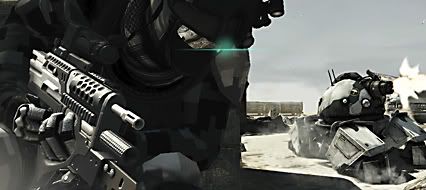 Fortunately, Ubisoft was smart enough to realize that this could be an advantage abused, and limited your use of the suit to compensate. When your gun goes off, even though it doesn’t make much sense, your suit will turn visible. Also, the user will have to recharge the suits battery. He would do this by, presumably, shutting it off for a short while.
Fortunately, Ubisoft was smart enough to realize that this could be an advantage abused, and limited your use of the suit to compensate. When your gun goes off, even though it doesn’t make much sense, your suit will turn visible. Also, the user will have to recharge the suits battery. He would do this by, presumably, shutting it off for a short while.
Another new feature is the ability to call your shots. In the single player campaign, which will run anywhere between 12-15 hours, the demo shows off the user controlled character sneaking up behind his target to apprehend him, all the while his three buddies are picked off with head shots from your own squad. Simple in single player, but in 4 player co-op, it could be a different story. It may be hard to coordinate this scenario, especially if you are not playing with friends willing to experience the game in a similar style as yourself.
If you were lucky enough to snatch up a copy of Splinter Cell: Conviction earlier this year, you’ll automatically be entered into a beta program for Future Solider, though the release of this beta client has yet to be revealed.
Look for Ghost Recon Future Soldier to hit shelves in download for all major consoles including Wii (though ignoring the PC, for some reason), as well as your DS and PSP in early 2011. Trust me. It will be worth waiting for the polish.
]]>
Harmonix and MTV just aren’t satisfied. They can do better.
MTV was showing off a bevy of new options this year, including a highly touted “All Instrument” mode. This mode allows easy access to three mics, bass, guitar, keyboard and drums all at the same time.
“In previous editions of the game, you’d have a group of friends over, but only 4 were able to use instruments. Maybe you’d have another buddy who’d love to sing along without a mic, but it just wasn’t the same. Now, almost everyone that can fit in your 500 sq.ft. apartment can join in,” said a Harmonix representative.

The game now caters to not only the hardest of core, but all the most casual. Rock Band 3 now features “No Fail” vocal tracks, and a “Song Filter,” which allowed players to search through all 1,500 potential Rock Band tracks by difficulty, genre, length, or almost anything any user might think of. The perfect party option to drop in and out of songs and sets was a fantastic idea long awaited, and finally implemented.
The two most amazing features new to this year were the addition of the keyboard, or keytar, and “Pro Guitar” mode. The keyboard allowed for two octave play, where the board would be divided into five sections, for five different notes. Where orange, the most difficult key in Rock Band, would have the smallest amount of keys committed to it, and green, the easiest, would have the most.
Pro Guitar, on the other hand, was the ability to have your special Rock Band guitar plugged into not only the game console, but a freestanding amp as well. On the fly, you could switch the game over from standard Rock Band music play, to playing through your amp, while Rock Band continues to track your progress. Because you were playing through an amp with a traditional guitar cable, the option to use distortion pedals was always an option, and even displayed to us through an elaborate stage show.
If you’re lenient about Rock Band at this point, don’t be. A lot of people might have been “Guitar Hero’d” out, but Rock Band 3 has given us every option to “drop in” again.
]]>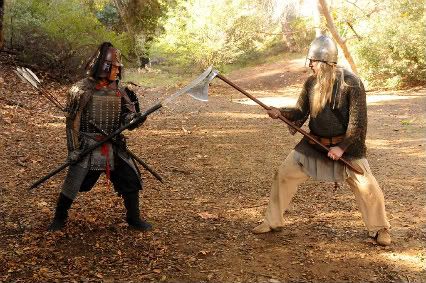 Pipeworks Software has found themselves in a very interesting position. Deadliest Warrior managed to find an excellent booth spot directly in the madness of the E3 South Hall entrance. Clearly, we’re supposed to care about this game based on marketing alone.
Pipeworks Software has found themselves in a very interesting position. Deadliest Warrior managed to find an excellent booth spot directly in the madness of the E3 South Hall entrance. Clearly, we’re supposed to care about this game based on marketing alone.
And maybe we should. A 2.5D fighting game, Deadliest Warrior throws legendary fighters from every era of human history against one another, in the fashion of the TV show of the same name.
The Deadliest Warrior won’t be the prettiest title available for download on either the PS3 or Xbox 360, but it is still impressive. Attack animations appear smooth and articulated, while character reactions to damage are haphazard and jarring. The animations being critiqued do not manage to remove you from the excitement, however, because the game prides itself on fast, furious, arcade-like action. In fact, it is mostly reminiscent of Bushido Blade in that regard. While not one hit kills, it isn’t impossible to land a 3 or 4 hit combo to finish off an opponent. Yeah. People die pretty easily in “realistic” situations.
Much like the TV show, players will find their fighters switching between weapons in the midst of combat. If your katana isn’t working against a blunderbuss, break out your long range shuriken and show that pirate what-for.
The combatants available for play are the the Apache, Knight, Ninja, Pirate, Samurai, Spartan and the Viking; all of which are warriors from season 1 of the show. Since season 2 has not fully aired, characters will be made available for download as they are revealed on television.
Look for the Deadliest Warrior to hit both Xbox Live and the PSN come the 4th quarter of 2010.
]]>
Today, Critical Gamer got some hands on time with Dance Central, which is being developed by Harmonix and being published by MTV Games, who if you didn’t know is also responsible for that little thing called Rockband.
On hand were some very friendly booth attendees and dance crews showing off the game before we here at E3 got to use it. After a short wait, and demo, I got to the dance floor to give it a try. This also gave me, personally, a chance to try Microsoft’s Kinect hardware for the very first time.
Right away I jumped into the controls. Users can use either their left or right hand to move the mode selection up or down and, depending what arm you use, swipe across the screen to the left/right to select song, difficulty and mode.
There were six songs to choose from: Poker Face (Lady Gaga), Body Movin (Beastie Boys), Poison (Bel Biv Devoe), Funky Town (Lipps Inc), Galang ’05 (M.I.A.),and Hella Good (No Doubt). Critical Gamer opted for Funky Town, obviously.
First of two modes sampled was “Break It Down!” This is the tutorial for the game, or if you’re having troubles with a song, it’s a good place to practice your moves.
After that they let me go into the actual dance mode. I accidentally selected medium difficulty from the menu so I got to dance moves I wasn’t prepared for. Good thing I had the friendly dance crews backing me up making me look good. Or maybe I made them look great.
There are on screen avatars showing all the movement, as well as “flash cards” showing the next upcoming move to get you ready. The avatars had glowing body parts highlighting the current body part in play. Beside the flash cards is a small screen with a silhouette of you through Kinect. The movements through Kinect to the screen came with little to no lag which was fantastic to experience.
So far the game seems fantastic, and we had a great time with it. It works great with Kinect. Dance Central releases this fall with 30 dance tracks and is one of the 15 launch titles for Xbox’s Kinect hardware.
 Valve had more to talk about regarding Portal 2 than just press conferences revealing their own sudden acceptance of the Playstation 3 platform, oh, no! Behind closed doors, Valve was very, very willing to answer journalist questions about new tools, weapons and story in regards to their next potential masterpiece.
Valve had more to talk about regarding Portal 2 than just press conferences revealing their own sudden acceptance of the Playstation 3 platform, oh, no! Behind closed doors, Valve was very, very willing to answer journalist questions about new tools, weapons and story in regards to their next potential masterpiece.
Portal 2 takes place a couple of years after the events of the original title. The character you control is, for whatever reason, revisiting the ruins of the original Aperture Science Lab, and let us tell you: GLaDOS is upset!
Yeah, it’s sort of a basic revenge flick. GLaDOS is rebuilding herself, and the Half-Life 2 engine looks to be pushed to it’s limits. While Portal 2 isn’t leaps and bounds above the original, the differences are still notable. It’s sharper, and looks to have more detailed textures this time around. In fact, it’s hard to tell it’s a 6 year old engine powering this title.
Notable to mention, is that an opposition to GLaDOS, seems to be helping you along this time. Whether this robotic eyeball device does more than talk to you or provide comedic relief was unclear, however.
 Included in the demo, Valve was showcasing of all sorts of new tools, including a certain form of paint, which is used to alter the properties of any environment. The two paints shown off so far, are blue or orange: one that makes the ground more bouncy, allowing you to get to higher points with jumps, or the other which allows the player to sprint at superhuman speeds.
Included in the demo, Valve was showcasing of all sorts of new tools, including a certain form of paint, which is used to alter the properties of any environment. The two paints shown off so far, are blue or orange: one that makes the ground more bouncy, allowing you to get to higher points with jumps, or the other which allows the player to sprint at superhuman speeds.
In addition to paint, were a series of platforms that acted similarly to how the springs acted in Sonic the Hedgehog. Jump on one, and if you were lucky, it might just float you to the next platform, which might send you to the next one, and so on.
Also introduced is the ability to redirect lasers with Companion Cubes. These lasers can then be used to either incinerate enemies, or activate buttons, allowing you to find the exit in one place.
Not mentioned in detail was cooperative play, but it has been mentioned that both users will be able to access all functions of their guns, meaning that 2 orange portals, and two blue portals may be open at any given time. It has also been mentioned that cooperative levels will be much more difficult than the single player experience, although gamers will, like most other Live or PSN titles, be able to use team chat in addition to laying markers about that will inform the second player about what he is needed to do, and where exactly his services are required.
 Also different from the first iteration, are the inclusion of new portal guns. One new ability allows for a sort of “hover” beam, that will project any object, including the user from point A to point B, as if it were in some sort of giant tube.
Also different from the first iteration, are the inclusion of new portal guns. One new ability allows for a sort of “hover” beam, that will project any object, including the user from point A to point B, as if it were in some sort of giant tube.
The other new portal, was one that acted as a sort of vortex that was willing to suck up almost everything it could “see” and teleport it to your secondary portal.
Valve has gone on record as saying that the game has been extensively tested in regards to gameplay. You won’t be taught all of your methods in the first hour of use, unlike many other FPS’s available; instead the player will continue to make use of 1, and then 2 skills (and so on), with a new ability being introduced every time it is believed the gamer will become tired of his existing move set.
Music wise, it seems as if Valve is trying to create a disconnect with how people might have viewed the original title. Obviously, Portal was a huge success, and the theme song ‘Still Alive’ managed to become a huge success, thanks to the quality work produced by Jon Coulton. It became an internet meme, and went as far as to being featured as a free download in MTV’s Rockband. While Coulton will still, most likely, be a featured artist, it is suggested that his certain comedic flair may be absent.
Portal 2 has been pushed back to 2011, but the wait is looking to be well worth it. Valve is regarded as a premiere developer, and they show no signs of changing that.
]]>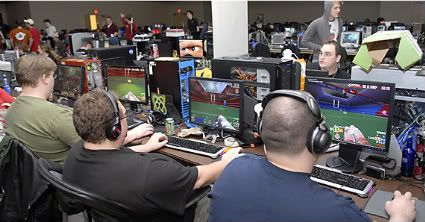
At some point, we have to face facts: not everyone is a hardcore gamer. Worse yet, the ratio of people actively playing games to the people who don’t know their thumb from their arse-end is something like 1:1,000.
Yes, chances are your friends aren’t gamers. Chances are your parents aren’t. Chances are your significant other isn’t. So who is, exactly? It probably isn’t the guy at the local Wal*Mart, even if he does work in your Electronics section.
Well, this is the future. You rely on the internet, of course. A fanciful, digital playground where you can hide yourself in a cloak of anonymity, feeling free to curse in Caps Lock about anything you want, any way you want, with little regard for tact or other people’s feelings.
Yes, the internet is a fun place worth exploring. Problems arise, however, if you fancy yourself some sort of socialite. Perhaps maintaining a digital persona isn’t enough for one’s self, and you have to reach out. You can spend all day trying to explain your hobby to your perfect honey, but chances are, she’ll just smile and nod, and from there on your relationship will disintegrate (I’m a pessimist).
From my perspective, I am lucky. I grew up on a street where two of my closest friends shared a similar core interest: gaming. We all share very different personalities, but oddly enough were able to meet a middle ground, shooting one another in split-screen tournaments of Quake 3 on the Sega Dreamcast.
Unfortunately, the days of sharing a street have long past. The commute back and forth is tiresome, and if I wanted to meet over a couple beers and discuss our life-long interests, it isn’t something I can do on a work night – and video chat doesn’t quite capture that face-to-face camaraderie.
Mentioned before in a previous article, were podcasts. I argued that in the absence of real human companionship, people might rely on gaming podcasts for their gaming news and socializing. The friendly format might allow an individual to almost transport themselves into the conversation being had by a table of journalists many hundreds of miles away. It is a mildly depressing theory, but one to take into account nonetheless.
I’m prone to doing extreme things to discuss my passions, as most people would or should. The question I’m posing to you, is this: If gaming is one of your most prominent activities, do you have an adequate outlet to vent about the almost awkward controls of ModNation Racers, or the eerily seducing, ambient sounds of Batman: Arkham Asylum?
]]>